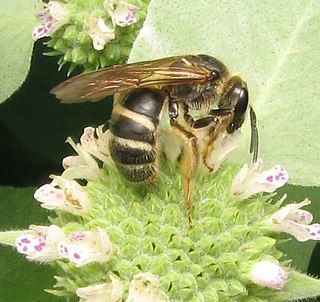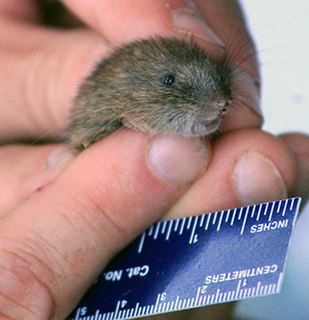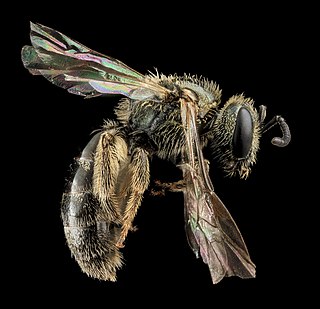
Halictidae is the second-largest family of bees with nearly 4,500 species. Halictid species are an extremely diverse group that can vary greatly in appearance. These bees occur all over the world and are found on every continent except Antarctica. Usually dark-colored and often metallic, halictids are found in various sizes, colors and patterns. Several species are all or partly green and a few are red, purple, or blue. A number of them have yellow markings, especially the males, which commonly have yellow faces, a pattern widespread among the various families of bees. The family is one of many with short tongues and is best distinguished by the arcuate basal vein found on the wing. Females in this family tend to be larger than the males.

The genus Arborimus is a group of voles found in western North America. The genus name is Latin for "tree mouse". Some sources include this genus with the heather voles, genus Phenacomys, and both are classified in the tribe Phenacomyini.

The sweat bee genus Lasioglossum is the largest of all bee genera, containing over 1700 species in numerous subgenera worldwide. They are highly variable in size, coloration, and sculpture; among the more unusual variants, some are cleptoparasites, some are nocturnal, and some are oligolectic. Most Lasioglossum species nest in the ground, but some nest in rotten logs.

The white-footed vole is a species of rodent in the family Cricetidae. It is found only in the United States. Its natural habitat is temperate forests.
The Ethiopian white-footed mouse or white-footed stenocephalemys is a species of rodent in the family Muridae. It lives in Ethiopia and Eritrea. Its natural habitats are tropical moist montane forest and tropical high-altitude shrubland.

Technomyrmex albipes, commonly known as the white-footed ant, is a species of ant first described in 1861 from Sulawesi, Indonesia by the British entomologist Frederick Smith. Invasive pest ants in Florida, previously identified as T. albipes, have now been separated as Technomyrmex difficilis, both forming part of a species complex with a worldwide distribution.

Neuroterus albipes is a gall wasp that forms chemically induced leaf galls on oak trees which has both bisexual and agamic generations and therefore forms two distinct galls, the smooth spangle gall and Schenck's gall. Neuroterus laeviusculus and Spathegaster albipes are previous binomials found in the literature.

Lasioglossum zephyrus is a sweat bee of the family Halictidae, found in the U.S. and Canada. It appears in the literature primarily under the misspelling "zephyrum". It is considered a primitively eusocial bee, although it may be facultatively solitary. The species nests in burrows in the soil.

Lasioglossum gotham, commonly known as the Gotham bee, is an extant species of sweat bee native to Eastern and Midwestern United States.

Lasioglossum vierecki, also known as Dialictus vierecki and Halictus vierecki, is a sand sweat bee and is part of the family Halictidae of the order Hymenoptera. It is found in the eastern half of North America from Minnesota to the New England States down to Georgia and Louisiana and up in Manitoba and Ontario. Commonly found in sandy areas, it pollinates various flowers such as grass-leaved goldenrod and rattlesnake master.

Lasioglossum sordidum, also referred to as the small native bee, is one of the smallest native bees found in New Zealand.

Lasioglossum bruneri is a species of sweat bee in the family Halictidae.
Lasioglossum mellipes is a species of sweat bee in the family Halictidae.

Homalictus is a subgenus of bees in the genus Lasioglossum subfamily Halictinae of the family Halictidae. They are found in Sri Lanka, Southeast Asia, east across the Pacific to the Mariana Islands, Samoa, Fiji and are most prevalent in Australia.
A list of the species of Hymenoptera from New Zealand; currently listing the 'stinging wasps' (Aculeata), which includes ants, bees, and social wasps.












